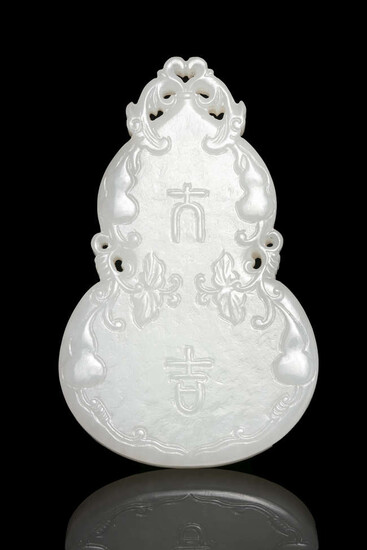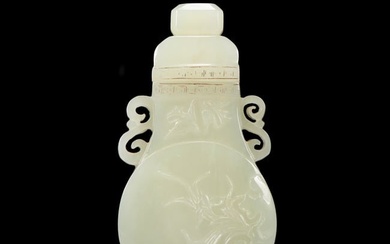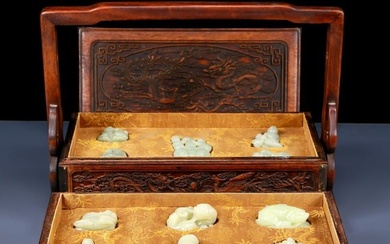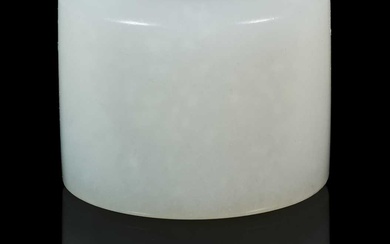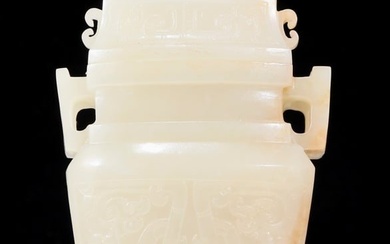*A FINE AND RARE WHITE JADE 'DA JI'...
*A FINE AND RARE WHITE JADE 'DA JI' DOUBLE-GOURD PLAQUE
China, Qing Dynasty, Attributed to Qialong period
The flattened section of very even white stone attractively carved around the edges with thin borders of small double gourds on a continuous leafy branch, the top with a pierced loop for suspension, the obverse carved in crisp shallow relief with the auspicious characters “da ji” (大吉), the reverse also “tian xi” (天喜), 'Heavenly bliss',carved in crisp shallow relief with the auspicious characters mounted within a wooden table screen also set with a carnelian plaque.
Dimensions:
- the plaque: H: 8 cm – w: 5 cm – thick.: 5 mm
- the table screen: 22,4 cm
Weight (the jade): 50 grams
Notes:
1. The inscription “dà jí” means “good fortune” while the inscription “tiān xǐ” means “Heavenly Bliss”.
2. The Chinese name for gourd (葫芦 hulu) also contains a homophone for words for protection or guard (护 hu) and also for blessing (祜 hu). The gourd is popular as a charm symbol to ward off evil spirits and disease because its first character (hulu 葫芦) has the same pronunciation as the word to "protect" or "guard" (hu 护) and also the word for "blessing" (hu 祜). In some dialects, the Chinese word for gourd (hulu 葫 芦) sounds the same as fulu (福 禄) which means "happiness and rank (as in attaining a high government office)". Trailing gourd vines are described in Chinese as man (蔓). This character can also be pronounced as wan and has the exact same pronunciation and meaning as 万 which means "10,000". Because the gourd contains many seeds, the Chinese associate the gourd with "10,000 children". In ancient China, parents hoped for many sons and grandsons so the gourd became an important symbol for a family with many children.
3. A related jade plaque from the Qing Court Collection is illustrated in The Complete Collection of Treasures of the Palace Museum: Jadeware (II), Hong Kong, 2008, no.71. Another related but smaller jade plaque was sold at Christie's New York on 22-23 March 2012, lot 1927. Also see a related plaque at Bonham’s London, United Kingdom, 2012/05/17, lot 41 sold for €57.656 BP incl.
上乘珍稀白玉“大吉”双葫芦牌
中国,清乾隆年间
* Lot imported from outside the EU under Temporary Admission. For Buyers in Ireland 13.5% import VAT will be charged on the hammer and 23% VAT will be charged on the buyers premium and invoiced on an inclusive basis under Irish Margin Scheme rules. Please see the title page VAT towards the back of the catalogue for more information. Buyers from other countries shouldfamiliarise themselves with rates of import duty in the country to which these goods may be exported
View it on
Sale price
Estimate
Time, Location
Auction House
*A FINE AND RARE WHITE JADE 'DA JI' DOUBLE-GOURD PLAQUE
China, Qing Dynasty, Attributed to Qialong period
The flattened section of very even white stone attractively carved around the edges with thin borders of small double gourds on a continuous leafy branch, the top with a pierced loop for suspension, the obverse carved in crisp shallow relief with the auspicious characters “da ji” (大吉), the reverse also “tian xi” (天喜), 'Heavenly bliss',carved in crisp shallow relief with the auspicious characters mounted within a wooden table screen also set with a carnelian plaque.
Dimensions:
- the plaque: H: 8 cm – w: 5 cm – thick.: 5 mm
- the table screen: 22,4 cm
Weight (the jade): 50 grams
Notes:
1. The inscription “dà jí” means “good fortune” while the inscription “tiān xǐ” means “Heavenly Bliss”.
2. The Chinese name for gourd (葫芦 hulu) also contains a homophone for words for protection or guard (护 hu) and also for blessing (祜 hu). The gourd is popular as a charm symbol to ward off evil spirits and disease because its first character (hulu 葫芦) has the same pronunciation as the word to "protect" or "guard" (hu 护) and also the word for "blessing" (hu 祜). In some dialects, the Chinese word for gourd (hulu 葫 芦) sounds the same as fulu (福 禄) which means "happiness and rank (as in attaining a high government office)". Trailing gourd vines are described in Chinese as man (蔓). This character can also be pronounced as wan and has the exact same pronunciation and meaning as 万 which means "10,000". Because the gourd contains many seeds, the Chinese associate the gourd with "10,000 children". In ancient China, parents hoped for many sons and grandsons so the gourd became an important symbol for a family with many children.
3. A related jade plaque from the Qing Court Collection is illustrated in The Complete Collection of Treasures of the Palace Museum: Jadeware (II), Hong Kong, 2008, no.71. Another related but smaller jade plaque was sold at Christie's New York on 22-23 March 2012, lot 1927. Also see a related plaque at Bonham’s London, United Kingdom, 2012/05/17, lot 41 sold for €57.656 BP incl.
上乘珍稀白玉“大吉”双葫芦牌
中国,清乾隆年间
* Lot imported from outside the EU under Temporary Admission. For Buyers in Ireland 13.5% import VAT will be charged on the hammer and 23% VAT will be charged on the buyers premium and invoiced on an inclusive basis under Irish Margin Scheme rules. Please see the title page VAT towards the back of the catalogue for more information. Buyers from other countries shouldfamiliarise themselves with rates of import duty in the country to which these goods may be exported
